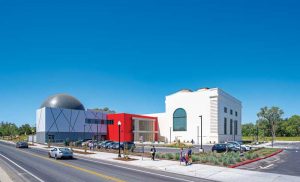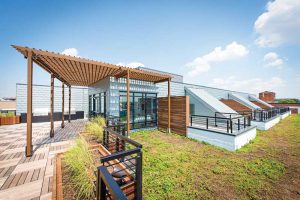
Supporting environmental and human wellness, the metal alloy that industry-leading architectural zinc manufacturers use does not contain lead, iron, cadmium, selenium, manganese, magnesium, or chromium-6.
Energy-efficient, low-emission production is part of what makes zinc roofing ecologically friendly. As little as one-quarter to one-third of the energy is necessary to produce architectural zinc alloys in comparison to other metals such as stainless steel, copper, and aluminum. This is because of zinc’s low melting point and its malleability. Manufacturers can minimize emissions during smelting and processing through state-of-the-art production equipment. In the highest quality manufacturing companies, pre-consumer scraps are 100 percent recycled.
High-quality zinc building products are infinitely recyclable without loss of its chemical or physical properties. Recycled content in architectural zinc products approaches 40 percent for pre-consumer content and 10 percent for post-consumer content, depending on the source.
In Europe, the recycling rate for zinc is more than 90 percent in the scrap industry. One reason for this is the high residual material value of up to 60 percent of the original material price, which makes it a strong incentive to collect scrap and waste materials. Architectural zinc’s material price and local labor costs may be higher than short-lived roofing materials; however, its multigenerational longevity make it a cost-effective choice over a building’s lifespan.
Further, zinc’s natural abundance, resiliency, recyclability, and longevity are recognized attributes in meeting the criteria of green building programs such as the Leadership in Energy and Environmental Design (LEED) rating systems by the U.S. Green Building Council (USGBC). Product and material testing and documentation are necessary to support sustainability claims. When assessing an architectural zinc product, one should request an environmental product declaration (EPD). EPD documents are third-party verified, internationally recognized, and standardized tools for assessing a building product’s sustainability.
Considering the entire lifecycle of a product or material, the Cradle to Cradle Products Innovation Institute’s (C2C) evaluation differs from other certifications in its focus on safe and sustainable products for a circular economy. To receive C2C certification, products are assessed across five categories: material health, product circularity, clean air and climate protection, water and soil stewardship, and social fairness.

Zinc roofing products
European building construction has relied on zinc roofing since the 1800s and continues to do so today. For example, 80 percent of the roofs in Paris are zinc, and their patina contributes to the city’s sophisticated architectural allure. There is even a movement to designate the Parisian zinc roofs as a United Nations Educational, Scientific and Cultural Organization (UNESCO) World Heritage Site.3
Drawing from its European design heritage, titanium zinc was introduced to North America as an architectural material in 1992. In the U.S., successful projects now can be seen from coast to coast, in all climate zones, and in a variety of building applications (Refer to Figure 1 and 2).




